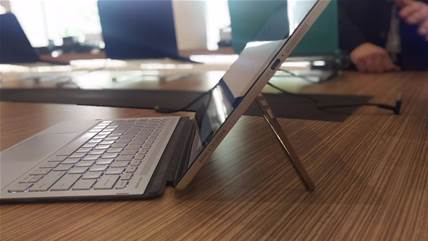Until now, HP hasn’t been able to hang with the likes of Apple – and more recently Microsoft –when it comes to hardware design.
When Microsoft introduced the first Surface in 2012, it hoped to spur on its OEM partners to create must-have, well-designed devices – an area that Apple has long dominated. Three years later, looking at the Spectre x360 laptop and Spectre x2 tablet, it seems HP got the memo.
Spectre x2
The Spectre x2 tablet comes with a detachable keyboard eerily similar to the Surface but with a larger trackpad (a huge problem for Surface). It measures 8mm thick and weighs 830 grams, with a 30cm screen (1cm smaller than Surface Pro 4). It’s powered with a 6th-gen Core M processor and an SSD up to 512GB.
Other than the improved keyboard, the biggest difference between the Spectre and Surface is the kickstand. Instead of one solid piece, the Spectre x2 has one steel beam to hold up the tablet when placed on a desk. The kickstand is held in place with a clip, rather than a magnet, which is unlocked with a button on the side of the device.
The Spectre x2 is available now starting at $1,499, putting it in the same ballpark as the Surface Pro 4, which will start at $1,349 when it launches at Microsoft's new Sydney Store on 12 November.
Spectre x360
Perhaps the biggest step for HP is the new Spectre x360, which will go up against the soon-to-be-released Surface Book, as well as the Macbook. HP has gone back to the drawing board and taken in customer feedback to produce a laptop with aesthetics in mind.
While the minimalist look may not please some, it seems like the “thinner and lighter” mantra has hit home for HP.
The Spectre x360 weighs 1.43 kilograms and measures 15.9 millimetres thick. HP has upgraded the device with Intel’s latest 6th-gen core i5 and i7 processors, dropping the option for an i3.
HP hasn’t sacrificed any ports, coming with a full-size HDMI and mini-DisplayPort 1.2, 3 USB 3.0 ports and SDXC-compatible SD card slot. HP also retained the same great keyboard.
While HP cited customer feedback for the latest hardware design changes, HP director of personal systems for South Pacific Paul Gracey said Microsoft’s latest hardware was helping to innovate the PC industry.
“Anything that innovates and progresses the category within the PC is a good thing, if it’s coming from Microsoft, so be it,” said Gracey.
“We’ve seen what they’ve done with Surface over the last 12 to 18 months and that innovation and marketing is good for the category.”
He added that markets such as BYOD environments had motivated HP into pushing aesthetics up on the company’s agenda. “I think it’s more about when did that customer choice start to deviate [the] view that manageability and security was utmost.
“I don’t think we’re past – certainly in the commercial and enterprise space – that security and manageability but [design is] definitely up there more so than it has been in the last four or five years,” said Gracey.
[Head-to-head: HP Spectre x360 vs Microsoft Surface Book]
HP is far from alone in pushing two-in-ones into the market. Lenovo, Dell, ASUS and Toshiba all have similar devices whether they have detachable keyboards or 360 degree rotating hinges. However, Surface Pro 3 still sits on top of the pile as the standard-bearer for tablets, so it’s no surprise OEM’s are finally taking cues from Microsoft.
According to Gartner, Microsoft has a 36 percent share of the “tablet ultramobile” market and is on track to sell 8 million tablets in 2015. The category is defined by devices with an optional detachable keyboard.
In the “tablet ultramobile” category, Asus was No.1, selling 3.1 million units in 2015 with a market share of 41 percent. Asus was the first OEM to sell two-in-one devices and now sells the Transformer Book T200.
Lenovo was second with 1.9 million units sold and HP third with 800,000 units.
Overall, Gartner predicts 21.5 million hybrid tablets will be sold in 2015, a growth of 77 percent from last year.
With the release of the Surface Pro 4 and Surface Book just around the corner, it wouldn’t be surprising to see even more Surface Pro lookalikes or refreshed designs.
Whatever it means, competition is always good.







.jpg&h=142&w=230&c=1&s=1)



_(21).jpg&h=142&w=230&c=1&s=1)




.jpg&w=100&c=1&s=0)






.jpg&q=95&h=298&w=480&c=1&s=1)




